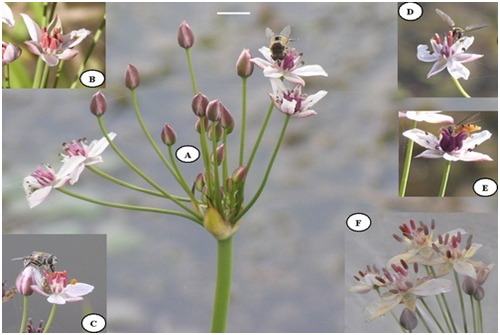Special Mechanism of Balance Selection Maintains Aquatic Plant Flower Color Polymorphism
2013-03-28
Aquatic plants displayed substantially adaptive traits in response to water environments. Studies on floral biology of aquatic plants provided ideal cases in understanding flower evolution.
The flowering rush (Butomus umbellatus L.) is an emerged plant with both clonal and sexual reproduction. Sexual reproduction exclusively depends on insect pollination for seed set while clonal reproduction is achieved by rhizome or inflorescence bulbils. In China, flowering rush mainly distributes in Northeast and its blooming period represents the months with highest rainfall of a year. Typically, gynoecia of the plants are red (R morph). Individuals with white gynoecia (W morph) are frequently found in some populations of the species in northeast China. Does there exist any adaptive traits in floral biology in response to heavy rainfall? What is the consequence of the interactions between individuals with different color in gynoecia and what is the mechanism maintaining flower color polymorphism for the species?
To answer these questions, Researchers from Key Laboratory of Aquatic Botany and Watershed Ecology, Wuhan Botanical Garden conducted field investigations as well as hand pollination treatments. Results indicated that the aquatic plant has a special strategy of pollen presentation, reversible anther opening. Detailed investigations revealed that the retractable anther epidermis cells response to water were the structural basis of the anther behavior. Such a mechanism could prolong pollen viability and avoid pollen wastage of the species and then, enhanced its male fitness. Research paper entitled "Reversible anther opening enhances male fitness in a dichogamous aquatic plant Butomus umbellatus L., the flowering rush” has been published in Aquatic Botany (2012, 99, 27-33).
Additionally, surveys on different populations of the plants with flower color dimorphism indicated that in pure population, plants of W morph have more seeds per fruit and more inflorescence bulbils compared to those of R morph. However, in mixed population, seeds per fruit significantly increase but inflorescence bulbils decrease for R morph plants while these parameters remain unchangeable for plants of W morph. Inter-morph hand pollination reveal an asymmetric pollen-pistil interaction between plants of R and W morph. Pollen of W morph can enhance both male and female fitness of red-flowered plants. Moreover, such a role is unilateral. The findings provide a special mechanism of balance selection, which contributes to maintaining flower color polymorphism of this aquatic clonal plant. Research paper entitled “Asymmetric pollen–pistil interactions contribute to maintaining floral colour polymorphism in a clonal aquatic plant (Butomus umbellatus L.)” has published in Aquatic Botany (2013, 106, 29-34).
Article link:
http://www.sciencedirect.com/science/article/pii/S0304377012000162
http://www.sciencedirect.com/science/article/pii/S0304377013000041
.
Characteristics of inflorescence, flower and anther for B. umbellatus. (Key Laboratory of Aquatic Botany and Watershed Ecology, WBG)